A “Fairer” Map for the 2022 House?
A potentially more representative map that still underscores deep flaws in our system.

Via FiveThirtyEight: The House Map’s Republican Bias Will Plummet In 2022 — Because Of Gerrymandering
No matter which way you slice it, Democrats have gained blue seats from the mapmaking process, making the House playing field between the two parties more balanced than it has been in decades. But that doesn’t mean the 2022 congressional map should be considered “fair.”
As the maps stand on March 30 at 5 p.m. Eastern, 175 congressional districts have a FiveThirtyEight partisan lean1 of D+5 or bluer, 181 have a partisan lean of R+5 or redder and 33 are in the “highly competitive” category between D+5 and R+5.
Here’s all of that visualized:
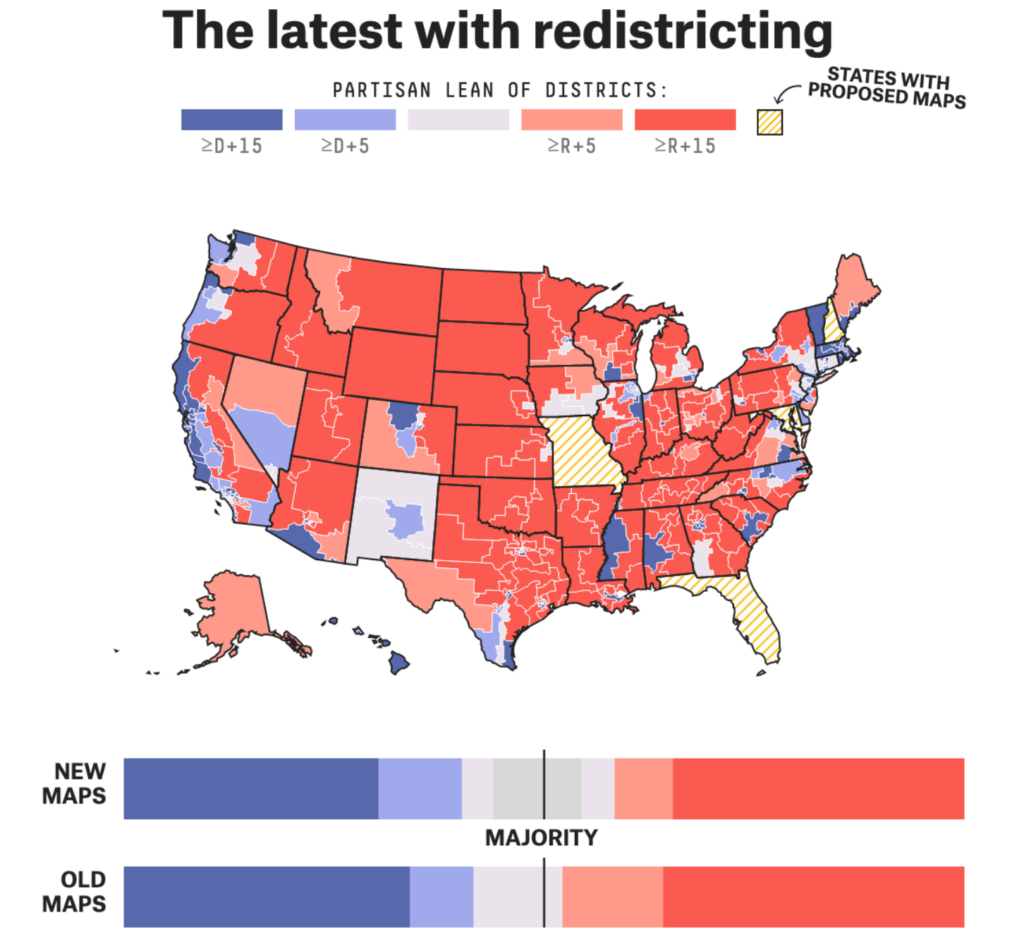
In summary:
That’s a net increase of 11 Democratic-leaning seats from the old maps. Meanwhile, the number of Republican-leaning seats has decreased by six, as has the number of highly competitive seats.
As the article notes, these lines do not guarantee the overall make-up of the Congress, as the national political climate comes into play in those competitive and leaning districts.
On the one hand, this is the fairest map in terms of the likelihood that the national popular vote will conform with who controls congress.
Since 1996, the tipping-point House seat has always had a FiveThirtyEight partisan lean of R+2.7 or redder. In recent years, it’s been closer to R+5 — meaning, in theory, Democrats have to win the national aggregate House vote by roughly 5 or more percentage points to win a majority in the House. Depending on how things shake out in the remaining four states, the tipping-point seat could be anywhere from R+1.0 to R+1.9 in 2022.
For example, in 2012 the Republican Party won a majority of House seats but did not win a majority of the vote for House seats nationally. This is problematic, to be kind, for a chamber that is supposed to be the most representative part of the federal government. (As I like to note, it is even in the name).
On the other hand, it should be noted that the correction to the overall representation question is created not by further placing the emphasis on the core of our supposed representative democracy, i.e., the vote and voters, but instead on the lines on the map. This is about the machinations and maneuverings well before elections rather than an actual improvement to the quality of those elections in terms of the connection between voters, their votes, and the office-holders they elect.
In many ways, our system is more predestination than it is representative democracy. By which I mean that the most salient variable for winning a House seat is the partisan lean of the district, which is essentially pre-determined by the districting process. Yes, migration patterns can change the content of districts, and in some cases the evolution of national politics can move a particular voter bloc from one party to another, hence changing the nature of a given set of districts. But the reality remains that the most important element of our system is not voters, but the way that voters are fenced in by district lines.
If the goal is a nation-level representative government then the system ought to have more features that actually emphasize representing the citizens of the nation, as well as creating a clear connection between voter preferences, their votes, and who is in office.
I cannot stress enough that the improved fairness outcomes of the new map have nothing to do with the content of the platforms of the parties nor the quality of the candidates. It has nothing to do with CRT, “defund the police,” the Big Lie, or gas prices.
It has nothing to do with voters changing their minds.
It doesn’t even have anything to do with changes to voters themselves.
It has to do with how the lines are drawn.
The main issue is where the voters are relative to those new lines, not what the voters want, per se.
A lot of people (including, I am certain, commenters on this site) are going to make a lot of sweeping claims about why we end up with whatever we end up with in November in terms of “Democrats should have said this, or shouldn’t have said that” as if the outcome of the election really, truly will be about voters evaluating policies and then making a collective choice. Not only is it incredibly difficult to link, with certainty, very specific issues to outcomes, but the reality also remains that most of these seats are predetermined regardless of what anyone says or does in the campaign.
Beyond all of that, we shouldn’t lose sight of the fact that the cost of a more balanced outcome nationally comes at the expense of local representation insofar as gerrymandering by both parties means that given states have skewed delegates. That is: Republican states in many cases produce more Republican representatives than is accurate for their state, and ditto for Democratic states.
Tennessee dismantled the blue district surrounding Nashville and turned it ruby-red. Utah declined to draw a Salt Lake City-centered district that would have been safely Democratic. New Mexico shifted its only red district 18 points to the left. New Jersey likely cut off Republicans’ chances to unseat three Democratic representatives (Josh Gottheimer, Andy Kim and Mikie Sherrill).
Put bluntly, the national House map still isn’t fair; its gerrymanders are just more fairly balanced. And the unfairness of the individual maps has other important consequences.
For instance, the new national map is also shaping up to be historically uncompetitive.
For example, in the 2020 presidential elections, New Jersey voted 57ish% for Biden and 41ish% for Trump. Using that as a rough guide the state’s House delegation ought to be (if it was reasonably representative of the partisan split in the state) something like 7 to 5. Under its 2022 maps, it is likely to be something like 9-3 or 10-2. It is hard to call that “representative” of the state, but move the lines around enough and you can produce a major advantage to the party that controls the state.
This isn’t healthy representative democracy.
Moreover, where is the democratic responsiveness in all of this? Where is the direct connection between the voter, even in the aggregate, and the elected official?
Alabama has seven districts and the partisan split is 6-1 (although it ought to be at 5-2, if not closer to 4-3 since the state splits roughly 62-37 R to D). The average partisan lean of each district is +38 (it ranges from +65 in AL04 to +29 for AL07, the lone Democratic seat). Let me ask you: what incentive do any of the Alabama delegation to the House have to worry about the needs of their districts? Or, do they only have to worry about winning their primaries? (Which could mean a range from no real contest at all to having to kowtow to the extremes of their parties).
I would note that this is how we get people like Marjorie Taylor Greene into office, and then have a hard time dislodging them. (BTW, her district, GA14, will have a +45 R lean going into November. If she is renominated, she will win re-election). Indeed, Georgia is a great illustration of the overall point. We know that it is close to being a 50-50 state in its overall partisan makeup, yet the new maps will give Rs at least nine of the state’s 14 seats (64.3%) and Ds only four (28.6%) with one competitive seat, according to 538.
This system does not promote representativeness, nor does it promote adequate democratic accountability.
It also means decreased competition:

Pretty much 313 seats are set in stone. That’s 71.95% of the House (with an additional 18.62% in wet cement). Only 9.43% of the chamber (42 seats) is truly competitive.
Let me repeat a phrase quoted above with emphasis: “Put bluntly, the national House map still isn’t fair; its gerrymanders are just more fairly balanced.”
In other words: improvements to overall balance have come about not by making the elections themselves fairer, but instead by both sides increasing the number of unfair distributions of seats in the states they control.
While an argument can be made that if we are going to play this game this outcome is better than one in which only one side is playing, if we are interested in actually representative democracy, this should be a concerning situation–especially when there are ways to fix it, which I say fully recognizing the hurdles to getting to such fixes.
—
A side note to consider: this outcome decreases the chances for structural reforms because it means that the party most threatened by the structural conditions of the system, the Democrats, have found a way to potentially overcome some of those disadvantages by more deeply playing the gerrymandering game.

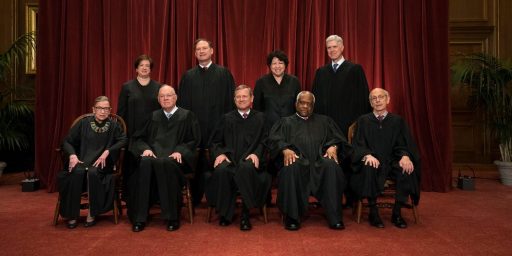
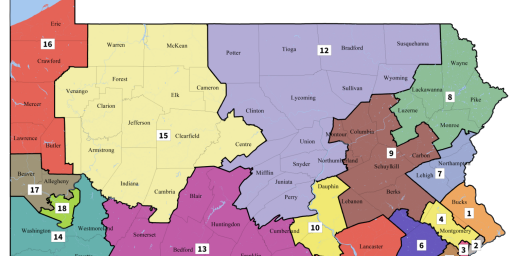
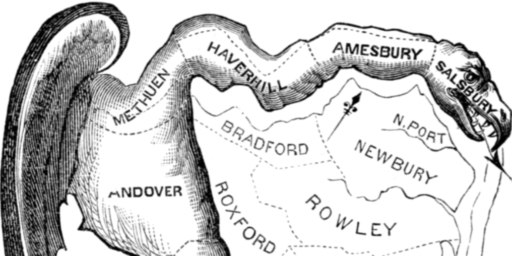
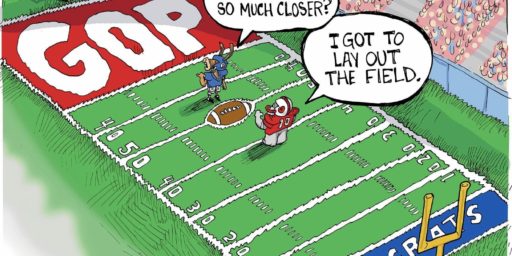

So long as we’re doing geographic districting that seeks to represent communities, there will be skews even if disinterested parties draw the lines. If Alabama is 67% Republican and 33% Democrat, it’s entirely possible to draw a “fair” map that comes out differently depending on how populations cluster.
Alabama has roughly 5 million people and only 5 municipalities of 100,000 or more.
I would presume that all of those except maybe Huntsville are heavily Democratic. But they all add up to 900,454—less than a fifth of the state’s population.
“Fair” really depends on the unit of analysis. Is it the country as a whole? The state? Some ephemeral sense of “community” or “locality” within the state? I can preach it any way.
That said, I read the 538 post the other day and didn’t have time to think through it. It’s certainly not the outcome we were expecting simply given that Red states gained seats in the reapportionment and Republicans control a disproportionate share of statehouses.
@James Joyner:
Which is why I prefer multi-seat districts with PR. It is more representative a given set of voters regardless of which set of arbitrary lines they reside in.
I do think that any standard of fairness has to start at the national level, especially for the national legislature.
Hmm, those hapless, incompetent Dems seem to have done OK here.
@James Joyner:
Indeed. There’s no way to slice a pie that everyone will regard as fair. All you can do is cut it into equal slices. My feeling is we should settle for procedural fairness in redistricting. Start with a population cartogram. A population cartogram is a map in which 1 sq in = say, 100,000 people rather than 10,000 acres. The maps above show what an unreal picture standard maps provide. If you have N seats, divide the cartogram into N equal geometric areas. Toss a die to decide where to start. Allow slight fudging to match streets, roads or rivers within some tight tolerance on equal population.
This eliminates the supposed problem of Ds being concentrated in cities. In a population cartogram they aren’t, cities become very large on the map. NYC would occupy about 44% of the map of NY state. It would eliminate the deliberately Black districts created in many states. But maybe we should recognize the impossibility of fudging the pie in a way everyone will like and settle for procedural fairness.
@gVOR08:
One reason that Dems appear to be doing better, is they have constructed more districts that while they lean Dem, also have a good likelihood of electing an R. R’s on the other hand felt comfortable enough with their advantage that they looked to make R leaning districts more secure.
Too early for back patting.
@Steven L. Taylor:
That option walked out the door 200+ years ago, absent an amendment. There probability of such an amendment seems to me to be lower now than at any other time in my life — there is a large minority of people who maintain that states are more than administrative districts. And they believe that giving up on that means the end of their way of life.
@Michael Cain: Actually, you could change the way we elect the House without amending the Constitution. It is an Article 1 power granted to Congress.
But, yes, the odds of change are low, as I noted in the post.
@Steven L. Taylor: @Michael Cain: Given that I think the arrangement crafted to meet the political situation of 1787 is wildly outmoded, I’d be happy with statewide MMDs to address the national-level issue. But that would create a second Senate rather than the local representation the House is ostensibly supposed to achieve. But we agree that it’s largely illusory, outside perhaps constituent service, because hyper-partisan districts skews incentives.
@James Joyner:
I understand why you say that, but I don’t it fully accurate, if anything because the allocation of seats would not be equal across states.
It would be an alteration of the current nature of representation, yes, but as noted in the post, it isn’t all its cracked up to be.
I think that the notion of territorial representation is overrated and that we cleave to it because it is part of our national mythology more than because it works the way we think it does. (But I recognize that is a loaded set of statements that requires unpacking–but that’s more than I am willing to do here at the moment).
@Steven L. Taylor: I think that the problem in the US is that even in a mixed systems politicians would have huge sway in drawing the lines of a multimember district. Completely eliminating them from the process would require an Amendment, right?
Ohio has still not set it’s districts. A couple of years ago voters approved a referendum that called for the redistricting to conform to the results of the most recent general election resulting in 54%-46% Republican advantage. The commission set up to draw the new lines has a 4-3 Republican advantage. Ohio currently has 15 districts. The commission has drawn at least 3 maps all of them reflecting, I believe, either a 12-3 or 11-4 Republican advantage. Democratic groups have filed appeals to the state Supreme court contending that the Commision is subverting the intent of the voter passed referendum and each time by a 5-4 vote has ruled the maps unfair and told the Commision to redraw the maps. The deciding vote on the Court is the 70 year old Republican Chief Justice Maureen O’Conner who evidently comes from a time when at least some Republicans believed in the rule of law. She is now the most hated Republican in the state. There have even been calls for her to be impeached. This has now put the state in the position of having to either delay the primary or hold a separate primary election for the House seats. Holding separate primaries will cost the state $25 million. The Democrats would probably settle for a 9-6 split. However, that’s not good enough for the Republicans so the whole ugly fight continues.
@Patrick McNicol: Thanks for the rundown.
And it is yet another example of where the lines are being more important than what the voters want.
@Andre Kenji: I think that the line-drawing process could be regulated by law as it falls under the “manner” in which elections are held.
I would note that gerrymandering multi-seat districts is a lot harder than doing it for SSDs-I am not going to say it is impossible to do for a given district, I don’t think a whole system can be gerrymandered using MMDs the way we are seeing here with SSDs.
It would also help if we increased the size of the House.